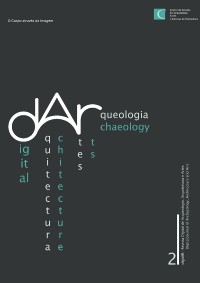Please use this identifier to cite or link to this item:
https://hdl.handle.net/10316.2/39300| DC Field | Value | Language |
|---|---|---|
| dc.contributor.author | Goulão, Maria José | - |
| dc.date.accessioned | 2016-09-01T22:54:27Z | |
| dc.date.accessioned | 2020-09-16T08:29:46Z | - |
| dc.date.available | 2016-09-01T22:54:27Z | |
| dc.date.available | 2020-09-16T08:29:46Z | - |
| dc.date.issued | 2015 | - |
| dc.identifier.issn | 2182-844X (digital) | - |
| dc.identifier.uri | https://hdl.handle.net/10316.2/39300 | - |
| dc.description.abstract | It is in the Renaissance that Europe, influenced by navigation and exploration travels, showed a renewed interest in representing the extra-European body. The inclusion of new continents in the European field of vision will give way to new forms of representation that sometimes correspond to forms of non-vision, or distorted vision. Europe will represent the foreign body of the Other, negotiating its image in order to incorporate spolia and exotica, but it will not exhaust itself in those "eccentricities". Europeans will also try to sort the novelty within familiar categories, looking for proximities and similarities that assume European customs as a starting point. The image of Native Americans is thus not constructed as a radically different Other, but rather translated into familiar archetypes, governed by the logic of similarity and conformed to worlds that, although strange, were quite comfortable for the European mind, since they had already been immortalized in earlier texts of antiquity and followed in the narratives of more recent trips. | eng |
| dc.description.abstract | É no Renascimento que a Europa, influenciada pelas viagens de navegação e exploração, manifesta um interesse renovado pela representação do corpo extra-europeu. A inclusão de novos continentes no campo de visão europeu dará origem a novas formas de representação, que correspondem por vezes a formas de não-visão, ou de visão distorcida. A Europa irá representar o corpo estranho do Outro, negociando a sua imagem de forma a incorporar spolia e exotica, mas não se esgota nestas “excentricidades”. Saberá também classificar a novidade dentro de categorias familiares, procurando proximidades e semelhanças que assumem os costumes europeus como ponto de partida. O nativo americano não é assim construído como um Outro radicalmente diferente, mas antes traduzido num arquétipo familiar, governado pela lógica da similitude e conformado aos mundos estranhos, mas relativamente confortáveis para a mente europeia, já antes imortalizados nos textos da Antiguidade e continuados nas narrativas de viagens mais recentes. | por |
| dc.language.iso | por | - |
| dc.publisher | Centro de Estudos em Arqueologia, Artes e Ciências do Património | - |
| dc.rights | open access | - |
| dc.subject | visual culture | eng |
| dc.subject | Renaissance | eng |
| dc.subject | iconography | eng |
| dc.subject | Indian | eng |
| dc.subject | wild man | eng |
| dc.subject | Cultura visual | por |
| dc.subject | Renascimento | por |
| dc.subject | iconografia | por |
| dc.subject | figuração do índio | por |
| dc.subject | homem selvagem | por |
| dc.title | Corpos estranhos: diferenças étnicas e construções raciais na cultura visual do Renascimento | por |
| dc.type | article | - |
| uc.publication.collection | digitAR nº 2 | - |
| uc.publication.firstPage | 65 | - |
| uc.publication.issue | 2 | - |
| uc.publication.lastPage | 86 | - |
| uc.publication.location | Coimbra | - |
| uc.publication.journalTitle | digitAR: Revista Digital de Arqueologia, Arquitectura e Artes | - |
| dc.identifier.doi | 10.14195/2182-844X_2_5 | - |
| uc.publication.section | II - Entre deuses e demónios | - |
| uc.publication.digCollection | IP | - |
| uc.publication.digCollection | B1 | - |
| uc.publication.orderno | 7 | - |
| uc.publication.area | Artes e Humanidades | - |
| uc.publication.manifest | https://dl.uc.pt/json/iiif/10316.2/39300/216455/manifest?manifest=/json/iiif/10316.2/39300/216455/manifest | - |
| uc.publication.thumbnail | https://dl.uc.pt/retrieve/11259421 | - |
| uc.itemId | 71411 | - |
| uc.thumbnail.uri | https://dl.uc.pt/iiif-imgsrv/11259374/dl!3!15!19!25!151925152759428121110727057046626337117 | - |
| item.grantfulltext | open | - |
| item.fulltext | With Fulltext | - |
| Appears in Collections: | digitAR: Revista Digital de Arqueologia, Arquitectura e Artes | |
Files in This Item:
| File | Description | Size | Format | |
|---|---|---|---|---|
| corpos_estranhos_diferencas_etnicas_e_construcoes_raciais.pdf | 1.8 MB | Adobe PDF |  |
Items in DSpace are protected by copyright, with all rights reserved, unless otherwise indicated.
